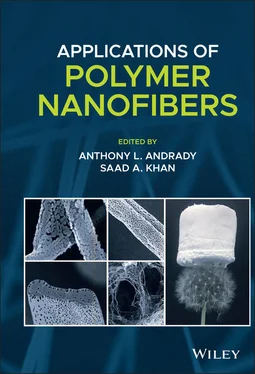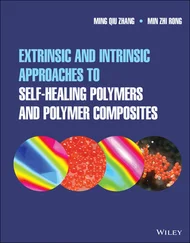Applications of Polymer Nanofibers
Здесь есть возможность читать онлайн «Applications of Polymer Nanofibers» — ознакомительный отрывок электронной книги совершенно бесплатно, а после прочтения отрывка купить полную версию. В некоторых случаях можно слушать аудио, скачать через торрент в формате fb2 и присутствует краткое содержание. Жанр: unrecognised, на английском языке. Описание произведения, (предисловие) а так же отзывы посетителей доступны на портале библиотеки ЛибКат.
- Название:Applications of Polymer Nanofibers
- Автор:
- Жанр:
- Год:неизвестен
- ISBN:нет данных
- Рейтинг книги:4 / 5. Голосов: 1
-
Избранное:Добавить в избранное
- Отзывы:
-
Ваша оценка:
- 80
- 1
- 2
- 3
- 4
- 5
Applications of Polymer Nanofibers: краткое содержание, описание и аннотация
Предлагаем к чтению аннотацию, описание, краткое содержание или предисловие (зависит от того, что написал сам автор книги «Applications of Polymer Nanofibers»). Если вы не нашли необходимую информацию о книге — напишите в комментариях, мы постараемся отыскать её.
Explore a comprehensive review of the practical experimental and technological details of polymer nanofibers with a leading new resource Applications of Polymer Nanofibers
Applications of Polymer Nanofibers
Applications of Polymer Nanofibers
Applications of Polymer Nanofibers — читать онлайн ознакомительный отрывок
Ниже представлен текст книги, разбитый по страницам. Система сохранения места последней прочитанной страницы, позволяет с удобством читать онлайн бесплатно книгу «Applications of Polymer Nanofibers», без необходимости каждый раз заново искать на чём Вы остановились. Поставьте закладку, и сможете в любой момент перейти на страницу, на которой закончили чтение.
Интервал:
Закладка:
1.6.3 Core–Shell Fibers
1.6.3.1 Coaxial Electrospinning
Hierarchically structured nanofibers, e.g. core–shell fibers have been of interest in a wide range of applications such as catalysis, drug delivery, and self‐healing materials (Li and Xia 2004; Crespy et al. 2012; Li et al. 2010; Moghe and Gupta 2008; Park and Braun 2010). One approach to making core–shell fibers has been coaxial electrospinning. In coaxial electrospinning, two polymer solutions are electrospun through a spinneret of two coaxial capillaries. Under steady operation, continuous, coaxial streams of both core and shell fluids are observed as they exit the nozzle. Following coaxial electrospinning, the core can be removed to achieve hollow fibers ( Figure 1.5). Alternatively, the sheath can be removed to achieve smaller nanofibers than can be achieved with conventional electrospinning. Generally, the electrospinning solution selected for the sheath is electrospinnable. The core fluid may be electrospinnable or one that does not readily form fibers when electrospun alone. The shell fluid envelops the core fluid and prevents the core fluid from breaking up into droplets. Stabilization occurs due to viscoelasticity of the shell solution and reduced surface tension at the core–shell interface. Selecting a common solvent results in particularly low interfacial tension. Since electrospinning is a relatively fast process, the core and shell solutions may or may not be miscible; the two fluids do not mix significantly over the short duration of the electrospinning process. One important consideration is solubility of the polymer solutions, i.e. the polymers must not precipitate at the fluid interface (Moghe and Gupta 2008; Yu et al. 2004).
Analogous to conventional electrospinning, solution properties of both solutions and process parameters, e.g. applied electric field strength, flow rates, affect fiber quality. The flow rates of the core and shell solutions are of particular practical importance. If the flow rate of the core is too high, the core fluid breaks up into droplets. If the flow rate of the shell is too high, the spinning of the core is not continuous and the fibers form without a continuous thread of core material. Generally, having the core flow rate lower than the sheath flow rates promotes stable jetting of both fluids. Further, the ratio of the diameter of the core to the shell and core loading are dictated by the flow rates (Moghe and Gupta 2008; Yu et al. 2004).
Coaxial extrusion enables electrospinning of fluids that are difficult to process. Typically, the nonelectrospinnable polymer is the core with an electrospinnable shell solution (Yu et al. 2004). For example, to produce superhydrophobic materials, Teflon amorphous fluoropolymer (AF) has been processed using polyvinylidene fluoride (PVDF) as the shell polymer. Teflon AF coating has also been applied to PVDF fibers by coaxial electrospinning PVDF as the core and Teflon AF as the shell (Muthiah et al. 2010). Coaxial electrospinning is also useful in biomedical applications. For example, coaxial electrospinning has been used for encapsulating biological components, e.g. proteins and cells (Crespy et al. 2012). Coaxial electrospinning has also been extended to tricomponent systems with triaxial spinnerets (Yu et al. 2015; Han and Steckl 2013). Coaxial electrospinning allows for control over the location of the therapeutic agent (or any other desired core or shell material) through the use of multiple concentric spinnerets. Utilizing triaxial electrospinning, gradient release of a drug agent over the period of 20 hours or dual drug release (Yu et al. 2015). Use of more complex multichannel spinnerets and hierarchical multichannel nanotubes has been achieved by removing the inner fluid solution after spinning (Li et al. 2010). Advanced hierarchical structure with advanced spatial distribution of nanoparticles within nanofibers has also been achieved by combining triaxial electrospinning and block copolymer self‐assembly (Kalra et al. 2009). Although coaxial electrospinning allows tuning the internal hierarchical structure of multicomponent fibers, the main disadvantage is the complex setup required, i.e. multiple pumps, complex spinneret configurations. Scalability has also been a concern, although, free surface electrospinning of multiple fluid layers to achieve coaxial fibers has been reported (Forward et al. 2013).
1.6.3.2 Emulsion Electrospinning
Coelectrospinning multiple fluids from a single spinneret to achieve core–shell fibers via phase separation is an alternative to coaxial electrospinning (Crespy et al. 2012; Yarin 2011). For example, when a polymer solution is emulsified with an immiscible solution (stabilized by surfactants) is electrospun, coaxial fibers can be achieved (Bannwarth et al. 2015; Bazilevsky et al. 2007; Xiaoqiang et al. 2017; Xu et al. 2006; Yang et al. 2008; Cai et al. 2016; Camerlo et al. 2013; Hu et al. 2014; Hu and Huang 2007; Jagur‐Grodzinski 2006; Li et al. 2010; Maretschek et al. 2008; Qi et al. 2006). The continuous phase of the emulsion is an electrospinnable polymer solution. During electrospinning, the dispersed droplets are stretched and elongated. Since the solvent evaporates from the outer shell solution faster than the core solution, the viscosity of the shell increases relative to the core. The viscosity gradient from the outer to inner layer forces the stretched droplets inward so that the dispersed phase is encapsulated within the fiber (Xu et al. 2006). Partial de‐emulsification, i.e. merging of the droplets during fiber formation is thought to result in a continuous core of dispersed phase (Hu et al. 2014). Mathematic modeling of the two‐phase flow indicates that annular flow, i.e. a continuous core, is expected when the Weber number is less than 0.5 and greater than 26 (Hu and Huang 2007). Note the Weber number is
(1.11) 
where ρ is the density of the core solution, v is the velocity of the core solution at the exit of the nozzle, d outeris the diameter of the outer needle, and σ is the surface tension coefficient (Hu and Huang 2007).
Oil‐in‐water (O/W) emulsions in which a hydrophobic component is encapsulated within a hydrophilic polymer (Xu et al. 2006; Maretschek et al. 2008; Qi et al. 2006) as well as water‐in‐oil (W/O) in which hydrophilic components are encapsulated within a water insoluble polymer (Bannwarth et al. 2015; Camerlo et al. 2013) have been reported. For O/W emulsions, typical core loadings are ~20% or less (weight ratio of core material to shell polymer) (Choi et al. 2011). The loading of dispersed phase in the nanofiber is typically 5% or less (mass of core:mass of shell polymer) for W/O systems (Yang et al. 2008). Thus, using emulsions, the loading of core materials is typically less than can be achieved with coaxial electrospinning. Surfactants are generally used to stabilize the emulsion. Surfactants with low HLB (hydrophile–lipophile balance) have been used to stabilize oil‐in‐water emulsions for electrospinning (e.g. sorbitan monooleate) (Cai et al. 2016). Surfactants with high HLB, e.g. sodium dodecyl sulfate, have been used to stabilize both oil‐in‐water and water‐in‐oil emulsions for electrospinning (Bannwarth et al. 2015; Xu et al. 2006; Yang et al. 2008). The emulsion is usually electrospun immediately after preparation to prevent premature phase separation (Cai et al. 2016; Camerlo et al. 2013; Garcia‐Moreno et al. 2016). Stabilizing the emulsion is a critical practical consideration.
1.7 Process Scalability
One key limitation to implementing electrospinning on a commercial production scale is the low production rate. Conventionally, production rates used with electrospinning are less than 0.3 g/h. To increase productivity, it is possible to increase the number of needles. However, the effect of additional needles/liquid jets on the electric field profile presents a significant challenge. Electrostatic repulsion limits the areal density of jets that can be achieved. There is strong repulsion among the jets which lead to poor fiber quality and reduced fiber production (Persano et al. 2013).
Читать дальшеИнтервал:
Закладка:
Похожие книги на «Applications of Polymer Nanofibers»
Представляем Вашему вниманию похожие книги на «Applications of Polymer Nanofibers» списком для выбора. Мы отобрали схожую по названию и смыслу литературу в надежде предоставить читателям больше вариантов отыскать новые, интересные, ещё непрочитанные произведения.
Обсуждение, отзывы о книге «Applications of Polymer Nanofibers» и просто собственные мнения читателей. Оставьте ваши комментарии, напишите, что Вы думаете о произведении, его смысле или главных героях. Укажите что конкретно понравилось, а что нет, и почему Вы так считаете.












